Mastering Hydrofoiling: Techniques and Tips for Riders


Intro
In the realm of water sports, hydrofoiling stands out as a captivating blend of skill and technology. Imagine gliding effortlessly above the water, feeling that euphoric rush as the board lifts, almost defying gravity. This exhilarating experience opens up a whole new dimension for kiteboarders and water enthusiasts. But how does one embark on this journey of hydrofoiling? This guide aims to unpack the essentials—helping you navigate through gear, techniques, and safety measures in this burgeoning sport.
Hydrofoiling utilizes a specialized board equipped with a foil. When moving at speed, the submerged foil generates lift, allowing the rider to rise above the water and experience a smoother glide. It’s not merely about the board or the wind; it’s an intricate dance of balance, body position, and technique. By understanding the nuances of hydrofoiling, both novices and experienced riders can elevate their craft and embrace the challenges that come with the waves.
Understanding the Basics
Before diving deeper into gear and advanced techniques, let’s take a moment to demystify the core concepts surrounding hydrofoiling. The key components include your foil, board, and, when kiteboarding, your kite. Each element plays a critical role in your overall performance. A sturdy yet lightweight setup can make the difference between a blissful ride and a frustrating tumble.
As we journey through this guide, great emphasis will be placed on the vital gear you’ll need to get started, along with insights for those who have more time on the water and are looking to refine their skills. This means every reader, from the fresh-faced beginner to the seasoned vet, should find invaluable insights to help them thrive in this thrilling adventure.
Understanding Hydrofoiling
In the world of water sports, hydrofoiling has emerged as an intriguing frontier, capturing the attention and curiosity of kiteboarders and water enthusiasts alike. Understanding hydrofoiling is pivotal because it not only elevates the rider above the water, providing a unique experience but also enhances overall performance in the sport. With its combination of innovation and skill, hydrofoiling offers benefits that push the boundaries of what can be achieved on water.
What is Hydrofoiling?
Hydrofoiling is a technique where a specialized board equipped with a foil lifts the rider above the water's surface. This separation from the water allows the board to move with significantly less drag, enabling higher speeds and a smoother ride. Essentially, the foil works by generating lift as the board moves forward. At spirited speeds, the board rises above the water, creating a sensation akin to flying over a surface rather than gliding on it.
The appeal lies in the combination of thrill and tranquility; as riders learn to master the nuances of hydrofoiling, they find themselves in a world where the noise of waves and wind intertwines with the feeling of flight. Many riders describe it as a transcendent feeling, where one moment they are skimming the water's surface, and the next they are soaring above, with only the splash of water beneath them.
The Physics Behind Hydrofoiling
To fully grasp hydrofoiling, it's essential to explore the physics that make it tick. The underlying principles hinge upon the science of hydrodynamics. When the foil, which is shaped like an airplane wing, cuts through the water, it generates lift due to pressure differences – higher pressure under the wing and lower pressure above it. This lift, combined with forward motion, allows the board to rise.
Here are a few critical aspects of the physics involved:
- Angle of Attack: How the foil is tilted in relation to the water surface significantly affects lift. A correct angle can create optimal lift and minimize drag.
- Speed: Faster speeds generate more lift. As the board accelerates, the foil functions efficiently, pushing the surface tension of water down, which enables the rider to elevate.
- Weight Distribution: Riders must adjust their weight to maintain balance and control as they transition from water to air. Leaning too far forward or backward can lead to losing lift or even a sudden dive back into the water.
Grasping these principles is critical for anyone looking to master hydrofoiling, as they dictate the fundamental experiences one can expect when venturing into this exhilarating realm.
Benefits of Hydrofoiling
The advantages of hydrofoiling stretch far and wide, encompassing both physical and emotional rewards that aren't easily found in traditional water sports. Here are several significant benefits:
- Less Resistance: The board experiences reduced drag, allowing for more effortless movement and greater speeds than traditional surfing or kiteboarding.
- Versatility: Hydrofoiling can be done in relatively small waves or even flat conditions, making it adaptable to various environments. This opens up opportunities for riders to practice and enjoy hydrofoiling in diverse settings.
- Smoother Rides: The elevation above the water reduces the jarring impacts of waves, creating a softer, smoother ride that many riders find addictive.
- Stunning Views: Being elevated changes the perspective dramatically; riders can enjoy breathtaking views of waterways and coastlines that are otherwise hidden at lower elevations.
Hydrofoiling transforms the boundaries of water sports, offering new thrills while maintaining a profound connection with nature. It embodies the fusion of physics and pleasure, inviting you to explore its waters.
Essential Equipment for Hydrofoiling
When stepping into the world of hydrofoiling, having the right equipment is crucial. Not only does it impact performance and comfort, but it also plays a significant role in your safety and overall experience on the water. Each piece of gear serves its own purpose and ensures that you can hydrofoil effectively and confidently. Here’s a closer look at the essential items you’ll need to get started.
Types of Hydrofoil Boards
Hydrofoil boards come in various shapes and sizes, tailored to different riding styles and conditions. Understanding the distinctions can greatly enhance your performance:
- Surfboards: These typically have a larger volume, making it easier to paddle out and catch waves. Ideal for ocean conditions where waves play a role in the ride.
- Kiteboards: These are often smaller and lighter, designed for optimal performance while kiting. They provide better maneuverability when soaring above the water.
- Paddleboards: A versatile option that can be used for hydrofoiling with a paddle, catering to those who enjoy fitness on the water along with the thrill of foiling.
Opting for the right board depends not only on your skill level but also on where you plan to ride. Advanced riders might prefer a board that allows for swift transitions and tricks, while beginners could benefit from a more stable board that is forgiving in its handling.
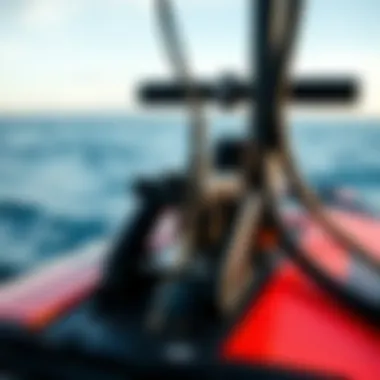
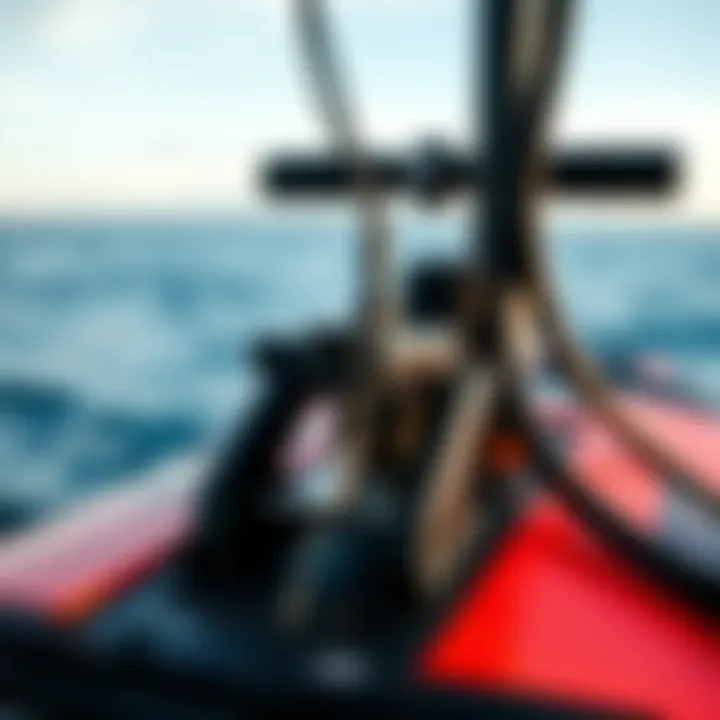
Selecting a Suitable Foil
Choosing a hydrofoil can feel overwhelming given the myriad of options available. However, some criteria can simplify your decision:
- Size of the Foil: Larger foils provide more lift and stability, great for beginners. Smaller foils offer speed and responsiveness, preferred by seasoned riders.
- Material: Aluminum foils are generally more affordable and durable, whereas carbon foils tend to be lighter and provide better performance but at a higher cost.
- Design: The construction of the wing matters significantly. A high-aspect wing is ideal for speed, while a low-aspect wing gives better maneuverability.
Researching specific foils like the Naish Thrust or Lift Foils can provide insights into performance characteristics, helping you find the one that fits your style.
Wetsuits and Safety Gear
While the thrilling aspects of hydrofoiling are enticing, safety should always be a priority. Here’s a breakdown of essential safety gear:
- Wetsuit: Depending on the water temperature, a good-quality wetsuit is essential. It not only keeps you warm but also provides buoyancy when you're in the water. Look for a thermally efficient material that allows for full range of motion.
- Impact Vest: These vests can offer extra cushioning in case of falls, which are likely to happen, especially for newbies. They also provide a bit of safety against unwanted collisions.
- Helmet: This is non-negotiable for both beginners and experienced riders. A well-fitted helmet can save you from severe head injuries if you take a tumble or get knocked around by your board.
- Leash: A reliable leash connects you to your board. It prevents the board from drifting away in the event of a fall, ensuring that you can quickly retrieve it.
To sum it up, investing in quality gear enhances your hydrofoiling experience and keeps you safe while you explore the waves.
Finale
Each element in this list contributes to not just the enjoyment of hydrofoiling, but also to building a solid foundation for one’s skills. Remember that the right equipment will undoubtedly influence your progression. Don’t rush the purchasing process; it pays to do thorough research and choose wisely. With the right gear, the thrill of hydrofoiling awaits!
Getting Started with Hydrofoiling
Getting into hydrofoiling can feel like diving into a new world, unlike any other water sport you might have experienced. The process is about getting set up correctly and understanding the intricacies of this captivating activity. It’s not just about riding a board, but rather mastering balance and technique while experiencing a sensation of flying over water. Whether you are a beginner or an experienced rider looking to expand your skills, the initial steps are crucial in laying down a solid foundation.
A good grip on the fundamentals will only enhance your riding skills in the long run. Moreover, learning about proper foot placement, technique, and other essentials will make the journey more enjoyable. This section will guide you, step by step, through the beginnings of hydrofoiling, ensuring you avoid pitfalls and seize the thrill of this unique sport.
First Steps for Beginners
Before gliding through the waters on your hydrofoil board, there are some initial preparations you should undertake. First, it's important to get the right gear. A hydrofoil setup usually consists of a board, foil, and hardware to attach them together. For beginners, a board with a larger surface area can significantly improve your balance, making it easier to get started.
Additionally, find a suitable location. Look for calm waters, as choppy waves can create frustrating situations for new riders. An area with a gentle incline is helpful too, as it allows for a softer landing. If you're unsure where to head, local kiteboarding schools often offer lessons at safe locations.
In terms of technique, you can start by practicing on land. Getting comfortable with the stance and movements before hitting the water can provide a sense of confidence. A few practice rides in shallow water can also ease your nerves before attempting full setups. Remember:
- Choose appropriate gear: A beginner board with wider dimensions.
- Practice on land: Familiarize yourself with footing, balance, and body posture.
- Use safe locations: Seek calm waters for your initial attempts.
Basic Techniques and Foot Placement
Once you've acquainted yourself with your gear, it’s time to dive into the nitty-gritty of riding. The first step is getting your foot placement right. Proper foot positioning can significantly impact your control and overall riding experience. As a rule of thumb, your back foot should be right above the foil while the front foot is positioned comfortably on the board.
Maintaining a low center of gravity is key. By keeping your knees slightly bent and your body relaxed, you allow for better balance. It's also crucial to shift your weight rather than overcompensating with upper body movements. Leaning slightly forward or backward will direct the foil's lift, ultimately determining whether you soar above or plunge under the water. Here's what you need to practice:
- Back foot centered over the foil - This placement affects lift and control.
- Front foot for stabilization - Maintain stability with a comfortable stance.
- Weight shifting - Subtle shifts can control your lift.
Common Mistakes to Avoid
Starting any new sport, often comes with its share of blunders. Hydrofoiling is no exception. Being aware of common pitfalls can help you sidestep them, enhancing your experience dramatically. One frequent issue involves incorrect foot placement, which can result in losing balance and control. It's essential to regularly check that your feet are positioned correctly to maintain lift.
Another common error is failing to adjust to the water conditions. New riders sometimes underestimate how these conditions influence their control. Adjust your technique accordingly — if the water’s choppy, stay relaxed and adjust your weight distribution.
Lastly, overthinking every motion can lead to improper responses during your ride. Keep in mind that hydrofoiling is partly about feeling the water beneath you and trusting your instincts. Here’s a handy list of things to keep in mind:
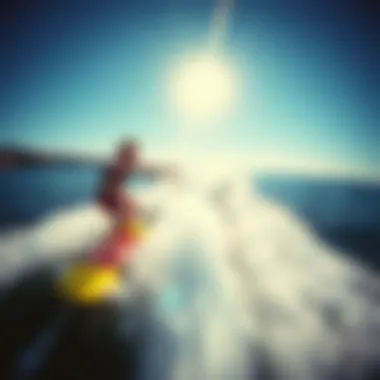
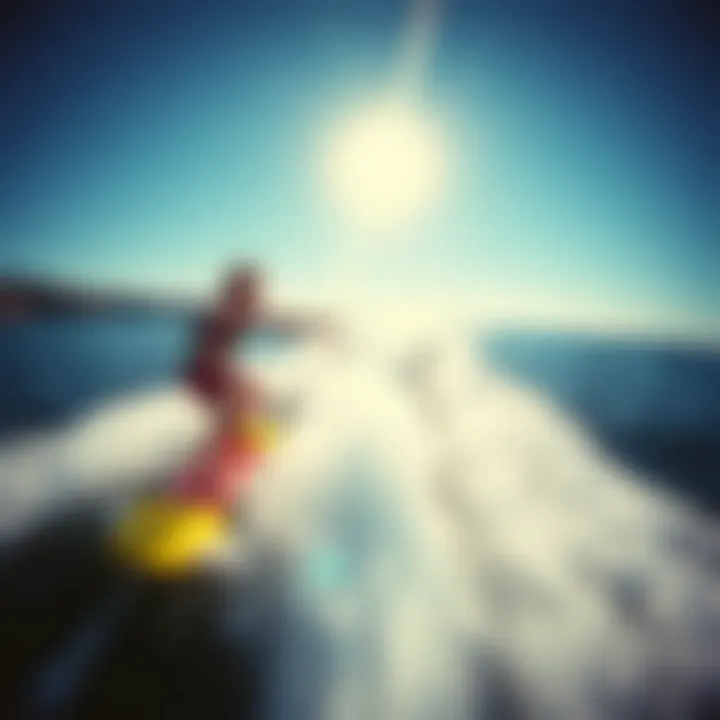
- Avoid overthinking movements: Trust your body and instincts.
- Check foot position frequently: Check if they are placed correctly.
- Adapt to water conditions: Make technique adjustments based on conditions.
By aiming to understand these initial elements of hydrofoiling, you create a strong starting point for an enjoyable and rewarding experience on the water. Remember, patience is a virtue as you learn this exhilarating sport.
Progressing Your Hydrofoiling Skills
As you embark on your journey of hydrofoiling, it’s essential to understand that this skill evolves over time. Progressing your hydrofoiling skills is not just about hanging on to the board; it’s about mastery, confidence, and an undeniable connection with the water. The thrill of gliding above the waves can be exhilarating, but to truly enjoy the experience, riders need to commit to refining their techniques.
Improving Control and Balance
Control and balance are the backbones of successful hydrofoiling. When riding, your ability to maintain a steady posture directly influences how easily you can maneuver the foil. This means that a solid stance is paramount. To improve balance, consider practicing on flat water first. It allows you to get the feel of the board without the added challenge of waves or currents.
- Maintain a low center of gravity; slightly bent knees can make a world of difference.
- Keep your arms loose, as stiff arms can lead to losing balance during turns.
- Use your core; it’s crucial for making subtle adjustments that help in controlling the flow of the ride.
As you become more comfortable, begin integrating gentle turns. Focus on shifting your weight and experimenting with your foot placements. Finding your sweet spot on the board can be a game-changer, making all the difference between a wobbly ride and a smooth glide.
“Practice makes perfect. Better control leads to more enjoyment.”
Advanced Maneuvers
With control and balance under your belt, it’s time to take a leap. Advanced maneuvers are key to impressing onlookers and enhancing your own experience. Maneuvers such as jibes, jumps, and spins not only require higher skill levels but also introduce an element of creativity to your style.
- Jibing: This involves turning the board without losing momentum. It’s essential to anticipate the turn and commit your weight forward, allowing more fluid movement.
- Jumping: This maneuver challenges both technique and timing. Start by building speed and then using the wave or water surface to lift off. As you become airborne, use your knees to absorb the landing.
- Spins: Once you are comfortable with both jibes and jumps, spins can add flair. Practicing the mechanics of turning your head and shoulders can encourage the board to follow suit.
These techniques require patience, practice, and even the occasional wipeout. Remember that every seasoned hydrofoiler has faced their fair share of falls.
Switch Riding Techniques
Switch riding, or riding with your non-dominant foot forward, is an art form that not only diversifies your skills but also enhances your overall control and adaptability on the water. It might feel awkward at first—like trying to write with your opposite hand—but it opens a world of possibilities.
- Start Slow: Begin incorporating switch riding in calmer conditions. Gradually increase your confidence by practicing short distances.
- Foot Placement: Pay close attention to your foot placement when transitioning to switch. It might take a few tries, but getting the right positioning will allow you to manage balance effectively.
- Visualize: As you ride, visualize the flow of water and your body’s reaction to it. It can help you anticipate movements and stay more balanced.
Ultimately, switch riding will not only enhance your overall technique but also prepare you for unexpected shifts in conditions, making you a more versatile hydrofoiler.
Mastering these advanced skills takes time and persistence, but the rewards are well worth the journey. You’ll find yourself carving through the waves with confidence, elevating your experience to new heights.
Safety Considerations
Hydrofoiling, while exhilarating, necessitates serious attention to safety. Understanding the inherent risks and employing best practices can significantly enhance your experience on the water. By prioritizing safety, you not only protect yourself but also nurture the sport’s integrity. Here’s a deep dive into various aspects of safety considerations for hydrofoiling, ensuring that your adventures remain thrilling yet secure.
Understanding the Risks
Every sport carries its share of risk, and hydrofoiling is no different. from the chance of falls to unpredictable water conditions, being aware of these hazards can help mitigate them. Hydrofoil accidents can lead to injuries that range from minor scrapes to more serious issues.
Consider these common risks:
- Falling: Losing balance while riding can result in falls that might lead to injuries, especially if you hit the water at speed.
- Equipment Failure: Understanding your gear is vital. A poorly maintained hydrofoil might malfunction at a critical moment.
- Interactions with Others: In crowded waters, collisions with boats, other riders, or equipment can cause injuries.
"Preparation is the key to minimizing risks. It's a bumpy road, but with the right precautions, you can navigate it safely."
Awareness and preparedness are your best allies when it comes to risks. Knowing the common pitfalls can help prevent unwanted accidents.
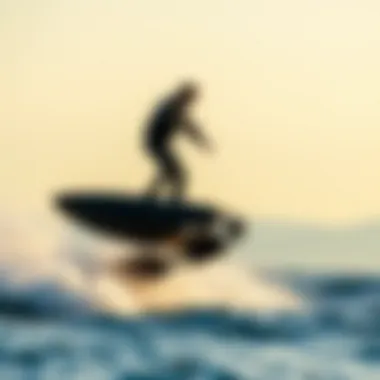
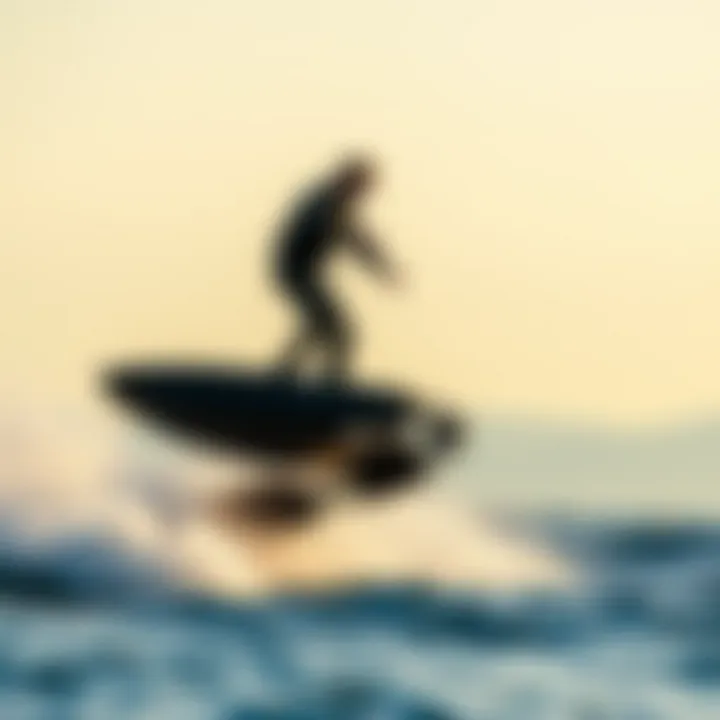
Water Conditions and Weather Factors
The environment you choose to hydrofoil in plays a pivotal role in your safety. Different water conditions can greatly affect how you ride. Here are a few primary points to consider:
- Wave Height: Large, choppy waves can disrupt balance and stability. It’s best to start with relatively calm conditions.
- Current Strength: Strong currents can make it harder to maintain control and lead to fatigue. Always check local tide charts before heading out.
- Weather Conditions: Sudden changes in weather can create dangerous situations. Be wary of approaching storms or wind shifts.
Consider using resources such as NOAA or local websites that assess water and weather conditions to make informed decisions. Always prioritize good conditions for a safer and more enjoyable outing.
Best Practices for Safety
To ensure a safer hydrofoiling experience, incorporating best practices into your routine is wise. Following some simple but effective guidelines will help keep mishaps at bay:
- Wear a Safety Vest: An impact vest not only offers padding when you fall but also more flotation for emergencies.
- Check Your Gear: Regularly inspect your hydrofoil and board for any signs of wear or damage. A stitch here or a tightening there can save you from a serious fall.
- Stay Visible: When riding among other boats or water sports enthusiasts, wear bright colors and use reflectors.
- Hydration and Rest: Remember to stay hydrated, and take breaks when you feel fatigued. Fatigue can lead to loss of concentration and increased risk of accidents.
Utilizing a buddy system is another excellent approach. Having a friend watch your back can enhance safety, especially for beginners.
Hydrofoiling Destinations
When you think of hydrofoiling, the focus often drifts toward the technical aspects of riding or the necessary gear. However, the location you choose to practice this thrilling sport can significantly enhance your experience. Hydrofoiling takes you above the waves, but finding the right spots not only allows you to glide smoothly but also ensures safety and excitement in your adventurous pursuits. Whether you're a newbie or a seasoned pro, knowing where to go can make all the difference.
Top Spots for Hydrofoiling
Many spots stand out for hydrofoiling worldwide, each offering unique conditions suited for different skill levels and preferences. Here are a few of the best places that experienced riders and rookies alike should consider:
- Cabo San Lucas, Mexico: With its warm, turquoise waters and consistent winds, Cabo provides an exhilarating environment for hydrofoiling. The views are breathtaking, and you can often find suitable spots close to beaches with excellent amenities.
- Maui, Hawaii: Known for its surfing culture, Maui also presents amazing hydrofoiling conditions. The waves here can be challenging, but the rewards in terms of scenic beauty and camaraderie with fellow water sports enthusiasts make it worth it.
- Lake Tahoe, California: If you're looking for freshwater destination, Lake Tahoe offers calm waters amidst stunning mountain views. This spot is especially good for beginners, as conditions can be more manageable away from ocean swells.
- Costa Brava, Spain: Offering a unique blend of cultural experiences and impressive hydrofoiling locations, Costa Brava has numerous beaches ideal for foil riding. The wind patterns are favorable, making it a hotspot for riders seeking variety in their sessions.
“Location is key in hydrofoiling; choose wisely to elevate your ride.”
While these spots are popular, don’t forget to explore local beaches and lakes not typically known for hydrofoiling. Unique conditions can often lead to hidden gems that offer a completely different riding experience.
Travel Tips for Hydrofoil Enthusiasts
Planning your next hydrofoiling adventure can feel overwhelming. However, a little preparation goes a long way. Here are several tips to enhance your travel experience:
- Research Local Conditions: Before you pack your gear, check the local weather forecasts, wind patterns, and even consult local hydrofoiling communities for insight. Knowledge of what to expect can help avoid disappointments.
- Renting Gear: If you're traveling far and can’t carry your gear, look into renting hydrofoil equipment locally. Many shops and schools offer rentals, so it’s worth reaching out ahead of time. This can also be a great chance to try out new gear.
- Stay Connected: Join hydrofoiling forums or groups on social media platforms like Facebook or Reddit. Tap into these networks for tips on the best spots to ride and upcoming local events. You might even arrange to meet up with fellow enthusiasts, enhancing your trip.
- Pack Smart: Besides your foil and board, remember to bring sunscreen, water shoes, and possibly a portable cooler for snacks. Hydrating during your sessions is essential, and a little food can keep your energy levels high for extended sessions.
- Respect Local Regulations: Each location may have different rules regarding hydrofoiling. Familiarizing yourself with local regulations will help ensure a hassle-free experience.
With these tips, your hydrofoiling trip is more likely to be smooth sailing, splashing through waves and reaching new heights on your foil.
The Future of Hydrofoiling
The horizon for hydrofoiling is looking quite promising, especially with advancements in technology and changes in how the sport is perceived. As more people become aware of the exhilarating experience hydrofoiling offers, its popularity is expected to surge. This section will delve into the innovations shaping the future of the sport and what could be on the horizon for enthusiastic riders.
Innovations in Hydrofoil Technology
Advancements in hydrofoil technology are driving this sport into new heights—or should we say depths? The recent innovations focus on increasing efficiency and performance. Manufacturers are experimenting with various materials and designs to produce lighter, stronger foils and boards. For instance, carbon fiber is increasingly common in construction, making boards more robust without adding weight.
- Electric Hydrofoils: Electric hydrofoils, often referred to as e-foils, have gained significant traction. They allow riders to glide above the water's surface without the need for wind or waves, essentially democratizing the sport. An e-foil is equipped with a quiet electric motor that gives you freedom to ride in a wider range of conditions.
- Smart Technology: Tech is also making its way into the water. Some new models come with built-in sensors that provide real-time data on speed, battery life, and performance metrics. This feedback can give riders insight into their skills and help them improve over time.
- Adaptable Designs: Manufacturers are increasingly creating customizable foils that can easily adapt for different styles, whether racing or leisure riding. This flexibility is opening doors for new riders who might be intimidated by the complexity of traditional setups.
"Innovation is the engine driving the future of hydrofoiling, making it more accessible and fun for everyone."
Predictions for the Sport's Evolution
As the technology develops, predictions for the evolution of hydrofoiling are leaning toward an exciting future. The sport is likely to see an influx of participants, stemming from a few noticeable trends:
- Increased Accessibility: With innovations like e-foils making the sport more beginner-friendly, we can expect to see a broader spectrum of enthusiasts hitting the water. More accessible means more participation, and that’s a win-win for the sport.
- Competitions and Events: Hydrofoiling competitions are likely to multiply as interest grows. Picture this: international pro tour events featuring hydrofoil racing, showcasing adrenaline-pumping performances while attracting sponsored riders from around the globe.
- Environmental Consideration: Eco-friendly movements might influence the sport's direction. As concerns increase over climate change, hydrofoil designs might incorporate sustainable materials, aligning the sport with a greener ethos.
In summary, the future of hydrofoiling holds promise for more accessibility, personalized experiences, and innovative designs. As technology continues to advance and inspire new ideas, the sport is well-poised for growth, ensuring that it will remain an exhilarating experience for generations of riders.















